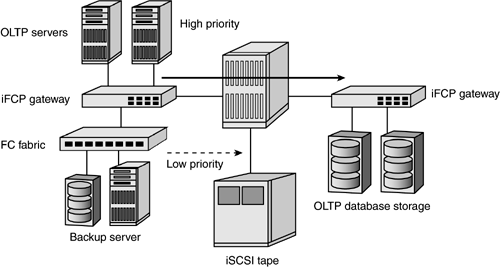6.4 Quality of Service for IP SANs
| IP storage is the opportunistic beneficiary of enhanced services that have already been developed for standard IP networking. As discussed in Section 6.1.1, quality of service (QoS) mechanisms provided by Gigabit Ethernet can be applied to both iSCSI traffic and Fibre Channel-originated traffic that has been converted to iFCP. QoS enables expedited delivery of higher-priority frames over lower-priority frames and so facilitates use of a common infrastructure to carry different types of storage data. As shown in Figure 6-16, prioritizing on-line transaction processing over tape backup streams ensures that the backup process will not disrupt incoming customer orders and revenue. Figure 6-16. Traffic prioritization through a shared Gigabit Ethernet transport
In addition to link layer traffic prioritization, IP networking standards support policy-based traffic management through Differentiated Services (DiffServ). As with header bit manipulation in IEEE 802.3p prioritization, DiffServ uses IP header bits to indicate as many as 64 different classes of service. The expanded classes of service options are rule-based and are meant to achieve various guarantees of delivery. How a vendor implements a specific class of service may vary. The result, however, should be the same, even across multivendor IP network infrastructures. Other quality of service offerings include Multi-Protocol Label Switching (MPLS) and Resource Reservation Protocol (RSVP). Both protocols establish data paths through the network to speed traffic flows and enable QoS enforcement. MPLS uses a packet labeling scheme to ensure that every packet is processed individually and handled according to its relative priority. RSVP, by contrast, establishes reserved routes through the network to guarantee available bandwidth from source to destination. This avoids individual packet processing but requires extensive coordination between network routers to establish and tear down routes. Whether at layer 2, layer 3, or switch-to-switch protocols, leveraging Gigabit Ethernet and IP quality of service for storage data requires end-to-end QoS protocol support by the intervening network equipment. |
EAN: 2147483647
Pages: 171
